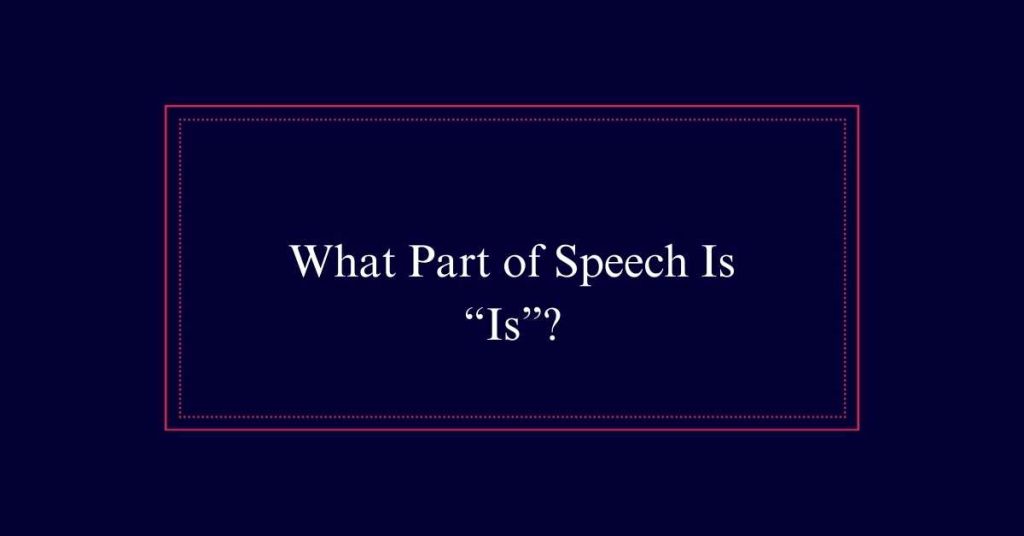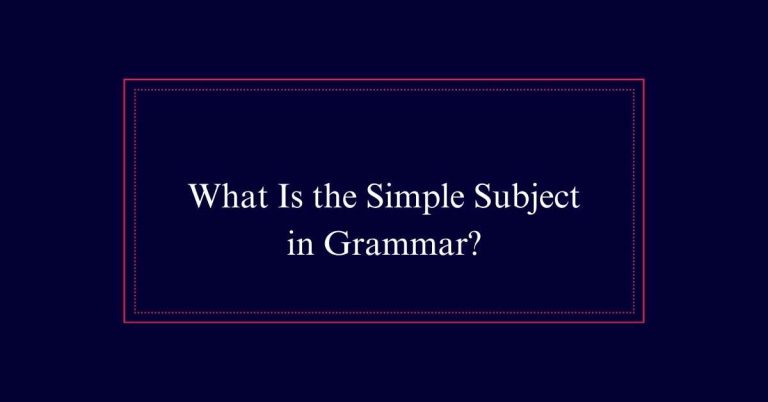What Part of Speech Is “Is”?
The word “is” serves as both a linking verb and an auxiliary verb in English grammar. As a linking verb, it connects the subject to a noun or adjective, providing more information about the subject. For example, “The bear is brown” or “My niece is valedictorian.” As an auxiliary verb, it helps form different tenses, moods, and voices, such as in “She is running” or “The cake is being baked.”
Linking Verbs Explained
Linking verbs frequently connect the subject of a sentence to a noun or an adjective that describes or identifies it. The verb ‘is’ is a common example of a linking verb. It does not show action but rather links the subject to more information about it.
For instance, in the sentence ‘The bear is brown,’ ‘is’ links the subject ‘bear’ to the adjective ‘brown.’ Similarly, in ‘My niece is her class’s valedictorian,’ ‘is’ connects the subject ‘niece’ to the noun ‘valedictorian.’
Auxiliary Verbs Defined
Auxiliary verbs, also known as helping verbs, assist the main verb in a sentence by expressing tense, mood, or voice. They are essential for constructing complex verb tenses, forming questions, and creating negatives.
In English, auxiliary verbs include forms of ‘to be,’ ‘to have,’ and ‘to do,’ as well as modal verbs like ‘can,’ ‘will,’ and ‘must.’
Here are some key points about auxiliary verbs:
- Express Tense: Indicate when an action takes place (past, present, future).
- Form Questions: Help to frame questions (e.g., ‘Is it raining?’).
- Create Negatives: Combine with ‘not’ to make negative statements (e.g., ‘She is not coming.’).
- Indicate Mood/Voice: Convey possibility, necessity, or passive voice.
Understanding auxiliary verbs is essential for mastering English grammar.
‘Is’ as a Linking Verb
The word ‘is’ serves as a linking verb when it connects the subject of a sentence to a noun or adjective that describes or identifies it. This function establishes a relationship between the subject and the complement, providing essential information about the subject.
For instance, in the sentence ‘The bear is brown,’ the word ‘is’ links the subject ‘bear’ to the adjective ‘brown,’ describing its color. Similarly, in ‘My niece is her class’s valedictorian,’ ‘is’ connects the subject ‘niece’ with the noun ‘valedictorian,’ identifying her status.

Linking verbs, like ‘is’, do not show action but rather serve to associate the subject with more information about its state or identity.
‘Is’ as an Auxiliary Verb
In addition to its role as a linking verb, ‘is’ also functions as an auxiliary verb, supporting the main verb in a sentence. As an auxiliary verb, ‘is’ helps to form various tenses, moods, and voices. It works alongside the main verb to provide a more complete meaning.
- Tense Formation: ‘Is’ helps create present continuous tense (e.g., ‘She is running’).
- Progressive Aspect: It indicates ongoing actions (e.g., ‘He is studying’).
- Passive Voice: Used to form a passive construction (e.g., ‘The cake is being baked’).
- Emphasis: Adds stress to the main verb (e.g., ‘He is trying hard’).
Examples of ‘Is’ in Use
Examples of ‘is’ in use demonstrate its dual function as both a linking and auxiliary verb. When used as a linking verb, ‘is’ connects the subject to a subject complement.
For instance, in ‘The bear is brown,’ ‘is’ links ‘bear’ to ‘brown,’ describing its attribute. Similarly, ‘My niece is her class’s valedictorian’ uses ‘is’ to link ‘niece’ to ‘valedictorian,’ indicating her role.
As an auxiliary verb, ‘is’ supports the main verb by forming continuous tenses.
For example, in ‘It is supposed to rain tonight,’ ‘is’ helps express the ongoing action of raining. Another example is ‘My mother is training for a 5k,’ where ‘is’ assists in indicating the continuing action of training.
Expressing Tense With ‘Is’
Expressing tense with ‘is’ often involves forming present continuous or present simple tenses to indicate ongoing actions or current states.
In the present continuous tense, ‘is’ combines with the present participle (verb ending in -ing) to describe actions happening right now. For instance, ‘She is reading.’
In the present simple tense, ‘is’ connects the subject to a state of being or an attribute, as in ‘He is happy.’
- Present Continuous: Shows an action in progress (e.g., ‘She is studying’).
- Present Simple: Indicates a general truth or state (e.g., ‘The sky is blue’).
- Linking Verb: Connects the subject to a descriptor or identifier (e.g., ‘The car is red’).
- Auxiliary Verb: Supports the main verb to show tense (e.g., ‘He is running’).
Common Uses of ‘Is’
The verb ‘is’ serves as an integral component in English, frequently appearing as both a linking verb and an auxiliary verb.
As a linking verb, ‘is’ connects the subject to a subject complement, which can be a noun or adjective.
As an auxiliary verb, it supports the main verb to form different tenses, moods, or voices. Understanding the uses of ‘is’ enhances sentence construction and clarity.
- *Linking Verb*: Connects subject to a complement (e.g., ‘The bear is brown.’)
- *Auxiliary Verb*: Helps form continuous tenses (e.g., ‘She is running.’)
- *Describes States*: Indicates existence or condition (e.g., ‘The book is overdue.’)
- *Third-Person Singular*: Used for he, she, it (e.g., ‘He is happy.’)
The Role of ‘Is’ in Sentences
In any sentence, ‘is’ functions either as a linking verb or an auxiliary verb to convey clear and precise meanings.
As a linking verb, ‘is’ connects the subject with a subject complement, which can be another noun or an adjective. For example, in ‘The bear is brown,’ ‘is’ links ‘bear’ to ‘brown.’
As an auxiliary verb, ‘is’ assists the main verb to form different tenses, moods, or voices. For instance, in ‘It is snowing,’ ‘is’ helps the verb ‘snowing’ to indicate the present continuous tense.
Understanding the role of ‘is’ in sentences helps in constructing grammatically correct sentences that accurately express the intended meaning.
Frequently Asked Questions
How Does ‘Is’ Differ From Other Forms of ‘To Be’?
The word ‘is’ is the third person singular present form of ‘to be.’ It differs from other forms like ‘am,’ ‘are,’ ‘was,’ and ‘were,’ which change based on tense and subject number.
Can ‘Is’ Be Used in Conditional Sentences?
Yes, ‘is’ can be used in conditional sentences. In such cases, it often appears in the present tense to describe a state or condition. For example: “If it is raining, we will stay indoors.”
How Is ‘Is’ Used in Reported Speech?
In reported speech, ‘is’ often changes to ‘was’ to reflect past tense. For example, “She says, ‘He is happy'” becomes “She said that he was happy.” This change maintains the sequence of tenses.






